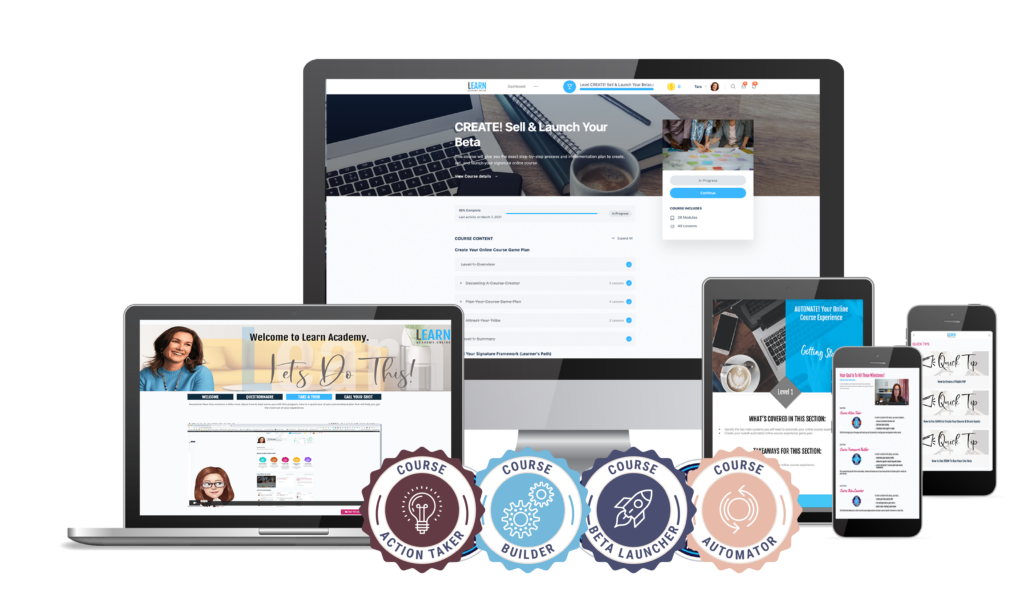The shocking truth about why billions of dollars in training investment produce zero measurable results – and the performance-based approach that actually works…
Most training programs have a dirty secret: most of it doesn’t work. Despite organizations spending over $370 billion annually on employee development, study after study shows that traditional training programs fail to produce meaningful behavior change or business results.
The culprit isn’t poor delivery or unmotivated learners – it’s a fundamental misunderstanding of what effective training should accomplish.
If you’re a learning and development professional, HR leader, or business executive frustrated by training programs that consume resources without delivering results, this article will transform how you think about creating and launching training programs.
We’ll explore why traditional approaches fail, introduce the performance-based methodology that actually works, and provide actionable strategies you can implement immediately.
The $370 Billion Problem: Why Most Training Programs Are Expensive ‘Information Dumps’
The Knowledge Transfer Illusion
The majority of training programs operate on a fundamentally flawed premise: that transferring knowledge to customers or employees will automatically improve their performance. This “knowledge-first” approach manifests in several ways:
- Information-heavy presentations that overwhelm learners with facts and concepts
- Awareness-building sessions that expose customers or employees to policies or issues without defining specific actions
- Compliance training that focuses on rules and regulations rather than required behaviors
- Leadership development that teaches theoretical frameworks instead of practical skills
The problem is obvious once you recognize it: organizations don’t pay employees to know things – they pay them to do things. An employee who can recite customer service principles but fails to resolve customer issues effectively provides no value. Knowledge without action is waste.
The Information Abundance Reality
We live in an era where information is instantly accessible. Customers and employees carry more information in their pockets than entire libraries once contained. Google, ChatGPT, and countless other tools provide instant access to facts, procedures, and explanations. With artificial intelligence capable of generating detailed explanations, code, reports, and analyses on demand, the value of memorized knowledge has plummeted to near zero.
What they need is not more information, but the ability to think critically about information, evaluate its relevance, and apply it effectively to solve real problems. Traditional training that focuses on knowledge acquisition represents a fundamental misunderstanding of modern work requirements.
The Awareness Trap
Perhaps the most wasteful form of workplace learning is “awareness training.” Organizations spend millions on programs designed to make employees “aware” of diversity and inclusion principles, cybersecurity risks, or company values. These programs create the illusion of progress while delivering no measurable outcomes.
Being “aware” of diversity principles doesn’t improve workplace culture; taking specific actions to create inclusive environments does. Understanding cybersecurity risks doesn’t protect company data; following specific security protocols does. Awareness without action is meaningless.
The Two Schools of Thought: Performance-Based Training vs. Learner Experience-Focused Design
Performance-Based Training: What Does the Learner Need to DO?
Performance-based training, rooted in modern instructional design principles, starts with a simple but powerful question: “What specific actions must learners perform to achieve desired results?” This approach eliminates the wasteful middle step of knowledge acquisition and focuses directly on behaviors that create value.
Key characteristics of performance-based training:
- Action-first methodology that starts with required behaviors
- Systematic approach following frameworks like ADDIE with performance focus
- Observable outcomes that can be measured in real work contexts
- Job-relevant practice that mirrors actual work situations
- Behavioral assessment based on demonstrated skills rather than knowledge recall
- Elimination of non-actionable content that doesn’t translate to performance improvement
Performance-based training recognizes that organizations invest in learning to improve results, not to increase general knowledge. Whether the context is compliance, skills development, or leadership training, the question remains the same: what specific actions must learners perform differently to achieve better outcomes?
Learner Experience Design: What Does the Learner Need to FEEL?
Learner Experience Design (LXD) represents a more recent evolution that prioritizes the holistic experience of the learner. Drawing from user experience design principles, LXD asks: “What do learners need to feel and experience to be motivated and engaged?”
Key characteristics of learner experience design:
- Human-centered approach prioritizing learner emotions and motivations
- Emphasis on engagement and intrinsic learning drivers
- Holistic journey consideration across multiple touchpoints
- Focus on usability and accessible design
- Iterative development with continuous user feedback
- Integration of multiple modalities and learning formats
While LXD can create more engaging experiences, it risks prioritizing satisfaction over results. Positive feelings about training that doesn’t translate to behavior change ultimately serves no organizational purpose.
The Obsolete Question: “What Do Learners Need to Know?”
The traditional training question “What do learners need to know?” has become not just outdated, but counterproductive in modern workplace learning. This knowledge-centered approach creates several fundamental problems:
The False Premise of Knowledge Transfer
Traditional training programs assume that transferring knowledge to learners will automatically result in improved performance. This assumption has been consistently disproven. Countless employees have sat through training sessions, successfully demonstrated knowledge on tests, and then returned to work with no behavior change whatsoever.
This approach wastes organizational resources and fails to deliver the business results that justify training investments. When training focuses on knowledge acquisition, it often overwhelms learners with information they don’t need for their specific role.
Critical Thinking Over Information Storage
What modern workers need is the ability to rapidly assess information, determine its relevance to their specific situation, and apply it effectively. This requires practice with real scenarios, not memorization of abstract concepts. Training should focus on developing judgment, decision-making skills, and the ability to take appropriate action under varying circumstances.
A Clear Stance on Training Value
Let’s be unequivocal: training that doesn’t produce measurable behavior change and business results is not training – it’s expensive entertainment. In a world where information is abundant and AI can provide instant answers, the only valuable training is performance-based and action-focused.
Organizations that continue to invest in knowledge-transfer or awareness-building programs are wasting resources that could be invested in training that actually improves performance and drives business results.
Actionable Strategies: How to Transform Your Training Programs
Strategy 1: Conduct a Performance-First Analysis
Before designing any training program, conduct a thorough analysis that focuses on required actions rather than knowledge gaps.
Action Steps:
- Identify performance problems – What specific behaviors are causing business issues?
- Analyze top performers – What actions do high performers take that others don’t?
- Define success metrics – How will you measure improved performance?
- Document required actions – Create a detailed list of specific behaviors learners must demonstrate
- Eliminate knowledge-only content – Remove any material that doesn’t directly support required actions
Example: Instead of “Employees need to understand customer service principles,” define “Employees must respond to customer complaints within 2 hours, use active listening techniques, and follow the three-step resolution process.”
Strategy 2: Design Action-Based Learning Experiences
Transform your training programs from information-heavy presentations to skill-building experiences that mirror real work situations.
Action Steps:
- Create realistic scenarios – Use actual workplace situations as learning contexts
- Design practice opportunities – Provide multiple chances to perform required actions
- Implement progressive skill building – Start with simple tasks and increase complexity
- Use authentic assessments – Evaluate performance in realistic contexts
- Provide immediate feedback – Offer specific guidance during practice sessions
Example: Instead of presenting slides about sales techniques, create role-playing scenarios where learners practice handling objections, asking qualifying questions, and closing deals.
Strategy 3: Eliminate Non-Actionable Content
Ruthlessly remove any training content that doesn’t directly support required performance outcomes.
Action Steps:
- Audit existing content – Review all training materials for actionable vs. informational content
- Apply the “So What?” test – For each piece of content, ask “What specific action does this enable?”
- Remove theoretical frameworks – Unless they directly support required behaviors
- Cut background information – Eliminate context that doesn’t improve performance
- Focus on decision-making – Emphasize when and how to take specific actions
Example: A cybersecurity training program should focus on “How to identify and report phishing attempts” rather than “Understanding the psychology of cybercriminals.”
Strategy 4: Implement Behavioral Measurement Systems
Replace knowledge-based assessments with performance-based measurement that tracks actual behavior change.
Action Steps:
- Define observable behaviors – Identify specific actions that can be measured
- Create performance rubrics – Establish clear criteria for successful performance
- Use workplace observations – Measure behavior in actual work contexts
- Track business metrics – Connect training to relevant business outcomes
- Implement continuous monitoring – Assess performance over time, not just immediately after training
Example: Measure customer service training success through resolution times, customer satisfaction scores, and observed use of communication techniques rather than test scores.
Strategy 5: Build Performance Support Systems
Create just-in-time resources that support performance at the moment of need rather than relying on memorized information.
Action Steps:
- Develop job aids – Create quick reference guides for complex procedures
- Implement decision trees – Provide step-by-step guidance for common situations
- Create mobile-friendly resources – Make support tools accessible on any device
- Use interactive guides – Develop tools that walk users through processes
- Establish peer support networks – Connect learners with experienced colleagues
Example: Instead of expecting salespeople to memorize product specifications, provide interactive tools that help them configure solutions based on customer needs.
Strategy 6: Focus on Critical Thinking and Decision-Making
Develop learners’ ability to evaluate information and make appropriate decisions rather than focusing on information retention.
Action Steps:
- Present complex scenarios – Use realistic situations that require judgment
- Teach decision-making frameworks – Provide structured approaches to problem-solving
- Practice with variations – Expose learners to multiple versions of similar situations
- Emphasize consequences – Show how different decisions lead to different outcomes
- Encourage reflection – Help learners understand their decision-making process
Example: Leadership training should focus on “How to handle difficult conversations” with practice scenarios rather than theoretical leadership models.
When to Use Performance-Based Training vs. Experience-Focused Design
Performance-Based Training is Optimal For:
All Workplace Training Scenarios: Since organizations invest in training to improve performance, not to increase general knowledge, performance-based training is appropriate for virtually all workplace learning contexts.
Compliance and Regulatory Training: Focus on specific behaviors like “Complete incident reports within 24 hours” rather than general knowledge about regulations.
Skills-Based Training Programs: Emphasize actions like “Generate monthly reports using pivot tables” rather than software features.
Sales and Customer Service Training: Concentrate on specific techniques like “Use the SPIN questioning method during discovery calls” rather than general sales theory.
Leadership Development: Focus on actionable skills like “Conduct effective one-on-one meetings” rather than leadership theories.
Experience-Focused Design Works Best For:
Long-term Behavior Change Initiatives: When sustained motivation is crucial for success, such as culture change programs or wellness initiatives.
Creative and Innovation Training: When learners need to develop critical thinking and problem-solving skills that require high engagement.
Voluntary Learning Programs: When participation is optional and intrinsic motivation is essential for success.
Diverse Adult Learners: When accommodating varied learning preferences and life circumstances is important.
Measuring Success: ROI and Performance Metrics
Traditional Metrics vs. Performance Metrics
Outdated Metrics to Avoid:
- Course completion rates
- Knowledge test scores
- Learner satisfaction surveys
- Hours of training delivered
Performance Metrics That Matter:
- Observable behavior change in workplace settings
- Improvement in job-relevant task performance
- Reduction in errors or safety incidents
- Increase in productivity or quality metrics
- Business outcomes tied to training objectives
Implementing Measurement Systems
Action Steps:
- Establish baseline performance – Measure current performance before training
- Define success criteria – Set specific, measurable performance targets
- Use multiple data sources – Combine observations, metrics, and business outcomes
- Track long-term impact – Measure performance weeks and months after training
- Calculate actual ROI – Connect training costs to business value generated
Case Study: Transforming Sales Training at TechCorp
The Problem
TechCorp’s sales team was struggling with long sales cycles and low conversion rates. Traditional training focused on product knowledge and sales theory, but performance remained poor.
The Performance-Based Solution
Instead of adding more product information, the training team identified specific actions that top performers used:
- Ask qualifying questions before presenting solutions
- Use customer language in proposals
- Follow up within 24 hours of initial contact
- Present ROI calculations in every proposal
The Training Design
- Scenario-based practice: Realistic customer interactions with feedback
- Peer observation: Sales reps observed top performers in action
- Performance coaching: Managers provided specific behavioral feedback
- Just-in-time resources: Mobile tools for objection handling and ROI calculations
The Results
- 35% reduction in sales cycle length
- 28% increase in conversion rates
- $2.3 million additional revenue attributed to training
- 15:1 ROI on training investment
The Future of Corporate Training: A Call to Action
For Learning Professionals Who Share This Vision
If you believe that training should produce measurable results, that every learning investment should improve performance, and that knowledge without action is waste, then performance-based training is your methodology. The field needs more practitioners who understand that our role is not to inform or educate, but to change behavior in ways that drive business results.
Your Next Steps:
- Audit your current programs – Identify which focus on knowledge vs. performance
- Redesign one pilot program – Transform a knowledge-based course into performance-based training
- Implement behavioral measurement – Track actual performance change, not just satisfaction
- Share your results – Demonstrate the business impact of performance-based approaches
- Advocate for change – Help your organization understand the difference between training and performance improvement
For Those Who Don’t Share This Vision
If you believe that training’s purpose is to share information, build awareness, or help people “understand” concepts without requiring specific behavioral change, then this approach is not for you. We fundamentally disagree about the purpose and value of workplace learning.
The Choice is Clear
The future belongs to learning professionals who can design training that produces real, measurable results. Everything else is just expensive entertainment that wastes organizational resources and fails to deliver the performance improvements that justify training investments.
Conclusion: Stop Wasting Money on Training That Doesn’t Work
Training programs have reached a crossroads. Organizations can continue investing billions in programs that make people “aware” of concepts and fill their heads with information they can access instantly on their phones. Or they can embrace performance-based training that focuses on what people need to DO to achieve better results.
The choice between these approaches isn’t just methodological – it’s fundamental. One approach wastes resources and fails to deliver results. The other transforms organizations by improving actual performance and driving business outcomes. Check out this article about learning in the flow of work.
The Bottom Line: Training that doesn’t produce measurable behavior change is not training – it’s expensive powerpoint presentations. In a world where information is abundant and AI can provide instant answers, the only valuable training is performance-based and action-focused.
Organizations that continue to invest in knowledge-transfer or awareness-building programs are squandering resources that could be directed toward training that actually improves performance and drives business results.
Your Action Plan:
- Evaluate your current training programs – Do they focus on knowledge or performance?
- Identify one program to transform – Start with a high-impact training initiative
- Apply the performance-based methodology – Focus on actions, not information
- Measure behavioral change – Track actual performance improvement
- Scale successful approaches – Expand performance-based training across your organization
The organizations that embrace performance-based training will gain competitive advantages through improved employee performance. Those that continue with traditional approaches will continue wasting resources on programs that don’t work.
Which approach will you choose?
Ready to transform your training programs from expensive information-dumps into performance-driving systems? Schedule a free discovery call to learn how our performance-based training methodology can deliver measurable results for your organization. We work exclusively with companies that want training programs that produce real business outcomes, not just satisfied participants.







